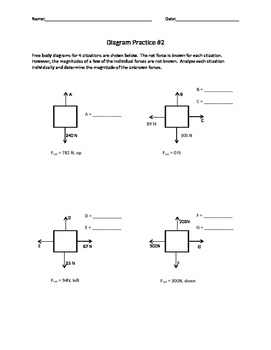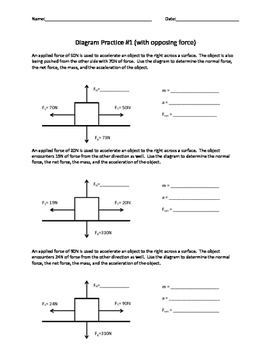Science: Motion, Acceleration, Newton's Second Law Worksheets!
Activities and Worksheets by Beverly
82 Followers
Grade Levels
6th - 12th, Higher Education, Adult Education, Homeschool
Subjects
Resource Type
Formats Included
- PDF
Pages
16 pages
Activities and Worksheets by Beverly
82 Followers
Description
Practice makes perfect! These are great for reinforcement after a lesson to verify students have learned the basics of instruction and are ready to start applying their knowledge in laboratories! Not only is it great practice, but, these will serve well for study guides for upcoming tests!
In this practice series, students will be able to learn and reinforce learning of the basics of acceleration and Newton's second law, both in a diagram format and a word based format. Scroll down for additional details about this product and the worksheets included in this bundle.
Other Worksheet Bundles:
Unit Conversions, SI Metric, US, Scientific Notation Worksheet Bundle
This worksheet bundle includes:
1. Motion
This is a worksheet that consists of 10 worded questions. Students will be required to obtain information from the question, setup the problem, and solve.
Example: "How long will it take a bicycle traveling at a constant speed of 20 m/s to cover a distance of 170 meters?".
2. Acceleration
This worksheet consists of 10 worded questions. Students will be required to obtain information from the question, setup the problem and identify the equation, and then solve.
Example: "Lisa drops a ball off a roof of a building. If the ball accelerates at 9.80 m/s2, how long will it take the ball to reach a velocity of 15.0 m/s?"
3. Acceleration #2
This worksheet consists of 10 worded questions. Students will be required to obtain information from the question, setup the problem and identify the equation, and then solve.
Example: "How far will a plane fly in 22 seconds if its velocity changes from 172 m/s to 80 m/s at a constant acceleration?"
4. Newton's Laws and Acceleration
This is another worksheet that consists of 5 worded questions. Students will be required to obtain information from the question, setup the problem, identify the equation, and then solve.
Example: "John’s car ran out of gas. He is pushing it to the nearest gas station with a force of 250N. Heath comes to help John and pushes with a force of 225N. If John’s car has a mass of 750 kg, what is the car’s acceleration?"
5. Newton's Second Law Diagram Practice
This is where it gets fun. Students are given written information about an object. There is a diagram that is partially labeled with the information presented. There are blanks on the diagram that the student must fill in. This is what the student will be graded on. There are actually THREE sheets to this worksheet. One does not include friction, the second does include friction, and the third includes opposing force.
6. Newton's Second Law Diagram Practice #2
In this worksheet, there are four free body diagrams drawn. The net force is known for each situation. The students must analyze and determine the magnitudes of specific individual forces.
7. Newton's Second Law Diagram Practice #3
More worded problems. This time there is no diagram presented. Students will be drawing and showing the forces acting on objects described to them in the problem.
8. Newton's Second Law Diagram Practice #4
This worksheet can be used in one of many ways. It is a combination of #1, 2, and 3. This can be used as a mid-assessment before a test, as homework, or even as a pop quiz or the final assessment.
9. Diagrams and Motion
This worksheet consists of five worded problems. Students will be required to use all of the knowledge or previous worksheets as well as interpret more data. Sometimes they will be required to sketch a free body diagram, sometimes they will have to calculate the normal force on an object. They will have to be aware on how to calculate the force, acceleration, draw diagrams, and use friction coefficients.
10. Vector Addition and Acceleration Worksheet
This is a worksheet that consists of five worded problems. Students will be required to read the question, analyze the given information, and solve. They will have to use information previously learned about vectors and vector addition.
Example: "John is flying a plane due east at 350 mi/hr. The wind is blowing in the same direction at 25 mi/hr. What is the resulting velocity of the plane?".
In this practice series, students will be able to learn and reinforce learning of the basics of acceleration and Newton's second law, both in a diagram format and a word based format. Scroll down for additional details about this product and the worksheets included in this bundle.
Other Worksheet Bundles:
Unit Conversions, SI Metric, US, Scientific Notation Worksheet Bundle
This worksheet bundle includes:
1. Motion
This is a worksheet that consists of 10 worded questions. Students will be required to obtain information from the question, setup the problem, and solve.
Example: "How long will it take a bicycle traveling at a constant speed of 20 m/s to cover a distance of 170 meters?".
2. Acceleration
This worksheet consists of 10 worded questions. Students will be required to obtain information from the question, setup the problem and identify the equation, and then solve.
Example: "Lisa drops a ball off a roof of a building. If the ball accelerates at 9.80 m/s2, how long will it take the ball to reach a velocity of 15.0 m/s?"
3. Acceleration #2
This worksheet consists of 10 worded questions. Students will be required to obtain information from the question, setup the problem and identify the equation, and then solve.
Example: "How far will a plane fly in 22 seconds if its velocity changes from 172 m/s to 80 m/s at a constant acceleration?"
4. Newton's Laws and Acceleration
This is another worksheet that consists of 5 worded questions. Students will be required to obtain information from the question, setup the problem, identify the equation, and then solve.
Example: "John’s car ran out of gas. He is pushing it to the nearest gas station with a force of 250N. Heath comes to help John and pushes with a force of 225N. If John’s car has a mass of 750 kg, what is the car’s acceleration?"
5. Newton's Second Law Diagram Practice
This is where it gets fun. Students are given written information about an object. There is a diagram that is partially labeled with the information presented. There are blanks on the diagram that the student must fill in. This is what the student will be graded on. There are actually THREE sheets to this worksheet. One does not include friction, the second does include friction, and the third includes opposing force.
6. Newton's Second Law Diagram Practice #2
In this worksheet, there are four free body diagrams drawn. The net force is known for each situation. The students must analyze and determine the magnitudes of specific individual forces.
7. Newton's Second Law Diagram Practice #3
More worded problems. This time there is no diagram presented. Students will be drawing and showing the forces acting on objects described to them in the problem.
8. Newton's Second Law Diagram Practice #4
This worksheet can be used in one of many ways. It is a combination of #1, 2, and 3. This can be used as a mid-assessment before a test, as homework, or even as a pop quiz or the final assessment.
9. Diagrams and Motion
This worksheet consists of five worded problems. Students will be required to use all of the knowledge or previous worksheets as well as interpret more data. Sometimes they will be required to sketch a free body diagram, sometimes they will have to calculate the normal force on an object. They will have to be aware on how to calculate the force, acceleration, draw diagrams, and use friction coefficients.
10. Vector Addition and Acceleration Worksheet
This is a worksheet that consists of five worded problems. Students will be required to read the question, analyze the given information, and solve. They will have to use information previously learned about vectors and vector addition.
Example: "John is flying a plane due east at 350 mi/hr. The wind is blowing in the same direction at 25 mi/hr. What is the resulting velocity of the plane?".
Total Pages
16 pages
Answer Key
Not Included
Teaching Duration
N/A
Report this resource to TPT
Reported resources will be reviewed by our team. Report this resource to let us know if this resource violates TPT’s content guidelines.





